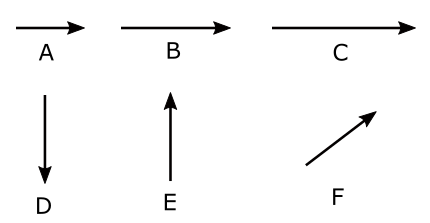LEARNING OBJECTIVE AS PER AP 1.1A.1: Scalars are quantities described by magnitude only; vectors are quantities described by both magnitude and direction. 1.1.A.2: Vectors can be visually modeled as arrows with appropriate direction and lengths proportional to their magnitude. 1.1.A.3: Distance and speed are examples of scalar quantities, while position, displacement, velocity, and acceleration are examples of vector quantities.
Suppose we wish to add numbers 3+2, simple arithmetic gives us the answer, 3+2 = 5.
It is interesting to note that in few scenarios this arithmetic fails. For example, If I move 3 meters to right and then 2 meters to left, the total distance I covered will be 3+2 = 5 meters. However, you will find that this sum doesn’t tell us the actual location of me. As I moved 3 meters to right and came back 2 meters to left my actual position is 3 m to right + 2 meters to left = 1 m to right from my starting point. Not 5 meters as obtained in the first case.
The difference in these two observations needs to be investigated and defined.
In the first case we simply added the quantity of movement that is 3 meters and 2 meters, hence we obtained 5 meters as total movement. We didn’t pay any attention to the direction of movement.
But in the second case we took into account the direction of movement as well as quantity of movement. First 3 meters to right (assume to be +) then 2 meters left (assumed to be -), hence we actually got displaced by an amount 3+(-2) = 1 meters in the positive direction or to the right.
Attaching information about the direction of movement on top of quantity of movement is essential in many practical scenarios. Suppose I wish to describe on how to go to school from my home. If I tell you go 2 miles, then 1 mile and then 3 miles. Clearly, the information provided is not sufficient. If I really hope that you can reach school from home, I will need to add the directional information. I will need to tell you that when you get out of the home first head 2 miles east, then 1 mile south and then 3 miles east. This way you will be able to reach school from home smoothly, without any confusion. If the directional information is missing, you will never be able to reach school.

Instead of adding the information of direction via text saying east, west, north south I could simply be more visual and use arrows. Ref to figure below:

If A is 1 mile to east, I can then draw a larger arrow twice the length in the same direction and it will represent 2 miles to the east and similarly C will represent 3 miles to the east and D will 2 miles to south and E will represent 2 miles to north and F will 2 miles to North-east.
In Physics, many such situations are encountered. Suppose there is a heavy trolley which we need to move. I ask you can you move it by applying some muscular force and you say yes sure. Then the obvious question arises in which direction should I apply the force. Even considering only two possibilities of PUSH or PULL I need to tell you beforehand if I wish the trolley to move to right or left. If I wish to move the trolley to left you will pull it, if I need to move the trolley to right you will need to push it.

Quantities or more specifically physical quantities (because we are studying Physics) whose complete specification is not possible without providing two information is called VECTOR (just a name really). Two information really are HOW MUCH (magnitude) and IN WHICH DIRECTION (direction). More formally,
Vector quantities are physical quantities which have both magnitude as well as directions.
What is a vector quantity?
Surely the displacement is a vector quantity (remember I got displaced by only 1 m to the right), the force is a vector quantity (we need to specify the direction). In fact as you will make your way into physics you will come across several such quantities which cannot be fully specified (defined) solely on the basis of how much (magnitude). Few examples include, velocity, acceleration, momentum, electric field , gravitational field and so on. You are not expected to know them right now, but keep an eye for them when they appear during your journey. These quantities are special ones and cannot be handled using arithmetic. We will need to devise a new method or math’s to handle them called Vector Algebra.
Moving on, it is quite clear that instead of using words to describe the direction of vector quantities we can use arrow to convey the same information. Longer the arrow larger the magnitude and the direction are represented by the head of the arrow. We use this quite frequently when dealing with vector quantities, being a bit visual helps simplify the vector mathematics, as we will see in the next section.
Well, quantities, which do not require specification of direction and can be completely specified on the basis of magnitude (how big or small) alone are called SCALAR. Clearly when we say my mass is 60 kgs, we are completely able to specify the physical quantity mass, all we need a scale of kilogram here or unit if you like. As we need a scale, hence the name SCALAR. Quantities such as mass, speed, charge, work and so on. Scalar quantities can be added using simple arithmetic, so for example, suppose my mass is 60 kgs and yours is 40 kgs, our combined mass is 60+40 = 100 kgs.
Well, adding vectors is different math al-together and that is what we will look at in the next section.
